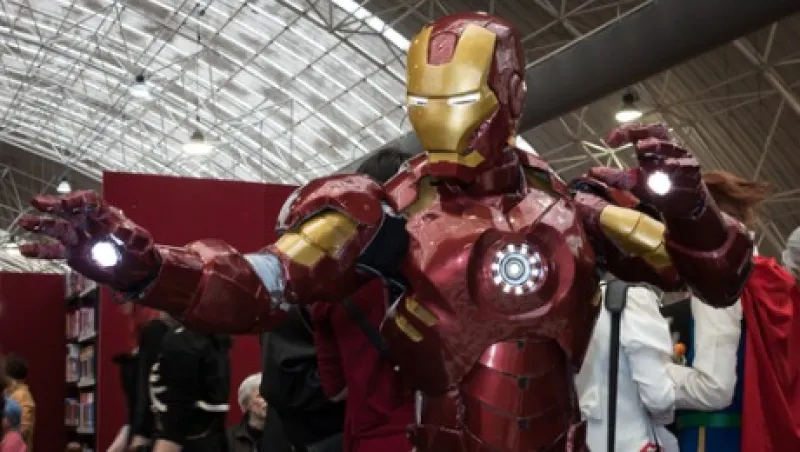In the world of technology, innovation is roughly equivalent to applied imagination. Innovators — the builders of the most startling new products and businesses — take their insights and convert them from wild ideas to a workable realities. It should come as no surprise, then, that the digital edge of technology and the Hollywood dream factory are merging; each depends on the projection of a story about a given aspect of our future. (Worth noting, as well, is a jump in mainstream science fiction films over the past 15 years.) Recently, both industries have come together on a specific project at the bidding of the U.S. military.
Over the past month, the U.S. military began discussing publicly a new robotic light artillery suit very much like that worn by Robert Downey Jr. in the Iron Man franchise. The Tactical Assault Light Operator Suit, or TALOS, is a flexible uniform enhanced with wearable computers and sensors that helps protect soldiers from injury. Depending on the project’s final outcome, it may also be a robotic exoskeleton that spreads the weight of the dozens of pounds of supplies, including water and ammunition, that soldiers must carry into almost all combat situations.
Increasing soldiers’ ability to evade and chase enemies — and to understand their own health and environment — would save lives and greatly improve their efficacy. Indeed, the concept and its worth are so obvious it might seem that TALOS would have been in the works long before Iron Man — though Special Operations Command’s first call for white papers and technologies toward its construction began in May 2013. Most of the recent press around TALOS, too, has focused on the fact that the military has brought on San Fernando, California–based special effects studio Legacy Effects with the deceptively simple goal of bringing Iron Man to life.
Whether Iron Man can be brought to life is another matter: Only those dreams that obey the laws of physics tend to make their way into the physical world. “When you’re doing something for a movie, it is all make-believe, whereas for the military that’s really not going to be the case,” commented Legacy Effects co-founder Lindsay MacGowan in the Wall Street Journal. The fully loaded Hollywood version of Iron Man’s suit — a perfect, virtually impenetrable, sensor-loaded combat suit — is certainly out of motor-actuated reach for next year’s war fighters, doubly or triply so because the project is backed by a budget of only $10 million a year.
A certain confusion persists, too, in the way TALOS has been described. Will it be lightweight and flexible enough to serve as an enhanced “uniform,” as some commentators have called it? Or will it require an exoskeleton of its own, in order to compensate for what may be a heavier burden on soldiers? (The Iron Man suit in which Downey acted weighed 90 pounds.)
Richmond, California–based Ekso Bionics, which primarily designs systems to aid patients with stroke-induced paralysis or other extreme challenges to mobility, is working to create such an exoskeleton — the kind of design that would drive TALOS away from a lightweight uniform toward something closer to a suit that would enclose the soldier’s body. Ekso’s existing model can assist patients with walking by sensing and amplifying their muscle movements; the relevance for the TALOS project is obvious.
Whatever its external structuring might be, TALOS is likely to include a wearable computer, similar to Google Glass, to help soldiers aim their weapons. (TrackingPoint, an application for Google Glass, gives users the ability to shoot around corners, an advantage in close combat.) Targeting technologies will surely find their place among TALOS’s gizmos. The Air Force is also testing Google Glass as part of a program designed to increase the capabilities of parachute-jumping medical personnel, who as soon as they land on the ground must rapidly sort through inputs about sites from above and track the needs of wounded soldiers. Fittingly, the name of that program is Battlefield Air Targeting Man-Aided Knowledge, or BATMAN. One gets the sense that the acronym may have been reverse engineered.
Drone warfare has escalated the number of battles fought without human casualty — at least to the party employing the drones. New battlefield technologies that extend the capabilities of infantry to advance against enemies and to defend and better protect — and even to heal — themselves will pick up on the ground the trend that drones have begun in the air. Cognitive enhancements like those offered by the computing systems in Google Glass and other wearables will make it easier for soldiers to keep track of and communicate with one another and for commanders to gauge immediately and accurately the health and position of troops. The Defense Advanced Research Projects Agency (DARPA) and other military organizations continue to reveal their work with robotics; soldiers will receive their own upgrades (frozen load-bars might become especially annoying mid-battle). While Tom Cruise battled aliens this summer in his exoskeleton at the Edge of Tomorrow (the title perhaps alluding to the delivery date of the technology as much as the premise of eternal recurrence), and as Tony Stark suits up again for the next chapter in Marvel’s billion-dollar movie franchise, the U.S. military is not leaving its own soldiers of innovation behind on the now half-century-old dream-battlefield dotted by robotically augmented human warriors.
Get more on trading and technology.






